相撲の概要 英語版
Sumo
Out Line
Sumo is a sports that everyone can enjoy.
The rule is very simple. This player will lose a match if step out from
dohyo, touch of any part of body outside dohyo, down into dohyo, touch
of any part of body but sole to surface of dohyo and make a faul.
Therer are professional sumo also, so called ozumo(grand sumo).
The Japan Sumo Association(Nihon Sumo Kyokai), a public corporate, is the
organization that promotes sumo's development as a mission. They are regularly
holding ozumo (professional sumo wrestling tournament)6 times throughout
a year. (January,March,May,July,September,November).Sumo is fought by a
tournament of 15 consecutive days.
Two sumo wrestlers so-called Rikishi wearing mawashi(sumo belt)only ,face
each other at both shikiri (the mark lined in white )of 70 cm in between
at the center of dohyo(solid sand mound of round shape) and rise to their
feet in the same breath within each limited time.
(4 minutes maximum for makuuchi(higher ranked sumo wrestlers)
,3 minutes for Juryo(middle ranked),
and 2 minutes for makushita and other(more lower ranked) . In ozumo, there
is no classification in bout by weight. which is characteristically different
from western wrestling.
buttles are judged to be lost in the match. The judgment is done by gyoji(sumo
referee)
butit is possible for maximum 5 other referees of ex-sumo wrestler watching
the match around dohyo to join the judgment.
There are 82 tricks and 5 non tricks and 8 fouls in sumo . Immediately
after match is over, both wrestlers ,regardless of bout outcome, have to
make a standing salutation with head down, respecting opponent for their
earnest fight politely. In the meantime, there are numerous amateur sumo
organizations which underpin ozumo. It is possible for amateur to join
ozumo. According to his outcome during his career of amateur age, he could
be starting from grade 10th to 15th of makushita. On the other hand, ex-sumo
wrestler is often coaching amateur . As such, they are cooperating each
other. We have, for example, Japan Sumo Confederation, Student Sumo Confederation
of National& Public University, Wanpaku(impish boy)SumoAssociation,
and so on. There are also a lot of sumo contest and/or championship of
amateur prevailing nationally and internationally. Amateur sumo is following
most of ozumo rule but sometimes they make an exceptional rule to have
the match by age or weight as follows; By Age = Classification of elementary,
middle and high school and university and open By Weight = Less Than 65
kg, LT75kg, LT85kg, LT100kg, LT115kg LT135kg and Free By Trick = Same 82
tricks and 5 non tricks as ozumo, but such dangerous acts as sabaori, (give
mawash i a jerk with downward strength ),kubinage(neck throw),and sorinage
(backward throw)are prohibited. Gyoji =One main referee and minimum one
sub referee Wears Allowed = Under-pants are possible for elementary and
middle school boys Sumo originally meant to wrestle strength with others,
so that the original Chinese letter for sumo was expressed as “角力”which
derives from “角てい”during Shin dynasty. Even today, we often say角界(kaku
kai)for sumo circle.
There are similar sports as sumo available in other parts of world;Bufu
in Mongol , Shirumu in Korea and wrestling in Turkey and other parts of Eurasia continent. A mural painting of caves alongside the Nile River of 2,500 years ago depicts men’s bout of wresting. So, it may be said that bout is an intuitive expression of healthy human beings to show his strength It also symbolizes each local character. And some had developed to current wrestling and other to sumo. Today, we have seen an influx of hopeful youngsters from overseas countries into ozumo to compete with native Japanese sumo wrestlers.
, Shirumu in Korea and wrestling in Turkey and other parts of Eurasia continent. A mural painting of caves alongside the Nile River of 2,500 years ago depicts men’s bout of wresting. So, it may be said that bout is an intuitive expression of healthy human beings to show his strength It also symbolizes each local character. And some had developed to current wrestling and other to sumo. Today, we have seen an influx of hopeful youngsters from overseas countries into ozumo to compete with native Japanese sumo wrestlers.
Sumo was originated for male sports but nowadays, sumo for female called
“New Sumo ”is also available. For this, an organization called Japan New
Sumo Confederation exists.
Sumo wrestler shall not be allowed to wear any but mawashi, but in case
that he is injured , he is allowed to wear bandage, supporter, and white
socks. This means that any seemingly offensive wears are not allowed to
use in sumo bout. Sumo was originally a part of Shinto (Japanese indigenous
religion)events. Most shrines held sumo contest when a festive was held
there. It was called as a dedicated sumo to shrine. Ozumo sometimes hold
a touring sumo at Ise Shrine and Yasukuni Shrine. They also hold a dedicated
sumo at Meiji Shrine when a new year comes and new Yokozuna( Champion sumo
wrestler) inaugurates. When wrestlers are displayed in the ring, they clap
their hands and Yokozuna tightens his tsuna(rope)mawashi. These derive
from Shime-Nawa of Shinto. And Shiko(stamping) is an important practice
of sumo trainings and at the same time, it means to drive evil- spirits
away, stamping them down to the earth.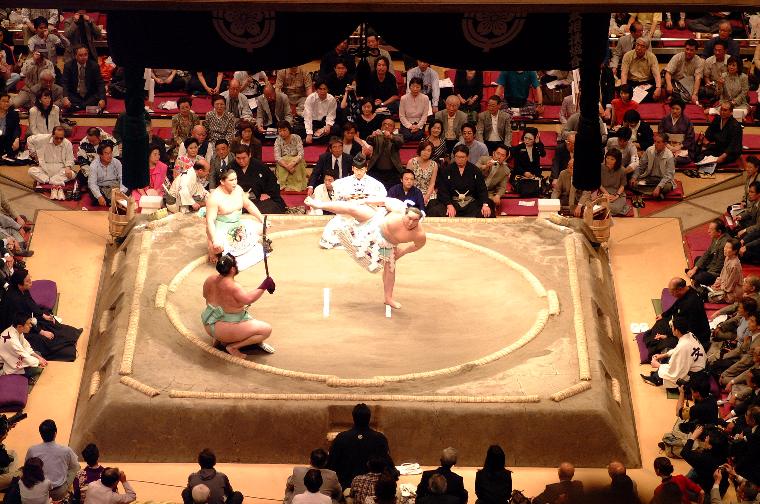
You also see that they clap their hands and extend their arms to both ends
and turn their palm down to the ground immediately after wrestlers are
displayed in the ring. This shows they have no weapons in their hands and
fight with unarmed. And other Shinto related sumo events are such as that
when dohyo-biraki(commencement of practice at dohyo) of each sumo-beya(training
room run by a factional boss of ex-sumo wrestlers)starts or on the very
day before a regular sumo tournament begins, dohyo-matsuri is held for
praying no accident at dohyo during the tournament. Gyoji, acting as Shinto
priest, recites Shinto prayer and offers sacred wine, chestnut, washed
rice, surume( dried squid), salt, thatch seed and tangle to four corners
of dohyo by which he could purify dohyo. As such, dohyo deems to be a sacred
place.
Until Meiji era started, no female could be permitted to see sumo. Even today, it is somehow controversial to have a female at dohyo.
As a rare Shinto event, there are “Naki-Sumo”(Weeping Sumo) 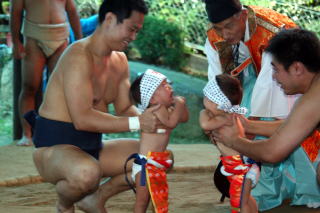 and “ Karasu-Sumo”(Raven Sumo). The former is to pray for infants steady
growth . Many shrines and temples throughout this country have long been
succeeding this tradion, while the latter storied that Kamotake-Tsunuminomikoto,
the grand father of the founder of Kamigamo Shrine in Kyoto led The Emperor
Jinmu to conquer his enemies resided in eastern Japan in his disguise of
a huge and wondrous raven and contributed a lot to its success. Sumo symbolizes
this religious event, driving evil-spirits away from a sacred place. In
fact, a sumo wrestler in disguise of Tone (warrior) holding a bow and arrow
imitates raven cawing and afterward, boys used to play sumo. Whenever we
have a festive, we are to hold sumo championship at the festive site. Originally,
shape and largeness of dohyo had not been fixed. some were square and others
round but in dual rounds. The largeness of dohyo was rather smaller than
current one. Currently, it is regulated that it should be round in encircled
with 20 small straw bags and 4.55 m in diameter while two shikiri(getting
off the mark) of white color must be lined at 70 cm in between at the center
of dohyo.
and “ Karasu-Sumo”(Raven Sumo). The former is to pray for infants steady
growth . Many shrines and temples throughout this country have long been
succeeding this tradion, while the latter storied that Kamotake-Tsunuminomikoto,
the grand father of the founder of Kamigamo Shrine in Kyoto led The Emperor
Jinmu to conquer his enemies resided in eastern Japan in his disguise of
a huge and wondrous raven and contributed a lot to its success. Sumo symbolizes
this religious event, driving evil-spirits away from a sacred place. In
fact, a sumo wrestler in disguise of Tone (warrior) holding a bow and arrow
imitates raven cawing and afterward, boys used to play sumo. Whenever we
have a festive, we are to hold sumo championship at the festive site. Originally,
shape and largeness of dohyo had not been fixed. some were square and others
round but in dual rounds. The largeness of dohyo was rather smaller than
current one. Currently, it is regulated that it should be round in encircled
with 20 small straw bags and 4.55 m in diameter while two shikiri(getting
off the mark) of white color must be lined at 70 cm in between at the center
of dohyo.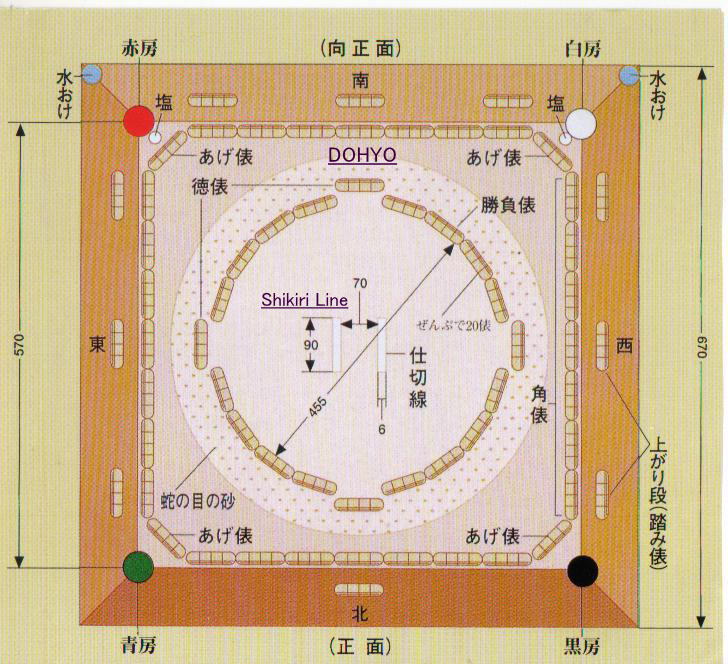
Sumo was originated long before dating back to era of The Emperor
Suinin in A.D.360 Since then until now, it has been loved by all layers
of people; nobles, warriors, laymen of this country with slight modifications
but the basic mode unchanged. Sumo is widely accepted in Shinto events,
local festivals, amateur sports and ohsumo, and thus, it is really worthy
to be called national game. It can also be developed to a further extent
and prevailed overseas countries as well. Sumo , together with Judo and
Kendo(Japanese fencing), became a compulsory subject of middle school athletics
from the year 24th Heisei(A.D.2012). Therefore, we can expect an increasing
number of students who select and practice sumo, thus building up a stout
body with a polite and high moral. And sumo also became well-known even
in foreign countries and those who love sumo are increasing to come to
Japan to enjoy sumo bout firsthand.

相撲の歴史 英語版
Sumo
History
Origin of sumo is very old. Ancient age tomb depicts sumo-like scene. When
we study sumo history, we find sumo is quite often told in myths. One of
those myths told us that two gods called ”Takemikazuchi” and “Takeminakata”
grabbed their arms each other and threw one another.
Apart from those myths, the oldest sumo match done by human being was said
the one between Nomino- Sukune and Tagimano-Kuehaya
and Tagimano-Kuehaya . In this match, Sukune kicked Kuehaya down to the earth. Kicking down
is not allowed in contemporary sumo. Although this was totally different
from existing sumo, Sukune, is anyhow, deemed as father of sumo.
. In this match, Sukune kicked Kuehaya down to the earth. Kicking down
is not allowed in contemporary sumo. Although this was totally different
from existing sumo, Sukune, is anyhow, deemed as father of sumo.
On July 7 of 7th year of The Emperor Suinin reign(A.D.360),Taimano -Kehaya
of Tagimamura,Yamato bragged himself saying that no one throughout this
country was stronger than him. Knowingly this rumor, The Emperor summoned
his subjects to recommend any sumo wrestler to compete with the bragger.
Accordingly, Nomino-Sukune from Izumo was recommended Then, the match was
set. This was considered origin of sumo.
However, this fight had, contrary to current sumo, been continued until
an either became fatally defeated. Sukune got Kehaya's ribs broken, thus
Kehaya was dead. With this win, Sukune was given Kuehaya's domain from
The Emperor and he was allowed to serve The Emperor as one of the majesty's
subjects. As his descendants became engaged in clay image firing works,
the family was donated the name “ Haji” from the royal highness. The Haji
family inclusive of Michizane Sugawara, then a most talented scholar and
,at the same time, influential government official became one of influential
clans. Because of this, we can notice Nomino-Sukune enshrined , together
with Michizane Sugawara at same time at Tenjin Shrines which were especially
built for Michizane . On the other hand, the eponymous shrines which Nomino-Sukune
is enshrined as a god of sumo are available in Tatsuno city ,Hyogo and
Sumida-ward, Tokyo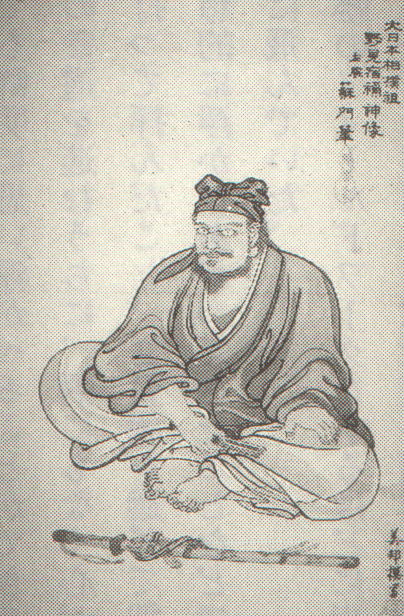 . Furthermore, there are epitaphs and/or five roofed stone towers(built
in early years of Kamakura era) praising Sukune’s achievement at 12 gods
shrines in Sakurai city, Nara and Izumo, Shimane.
. Furthermore, there are epitaphs and/or five roofed stone towers(built
in early years of Kamakura era) praising Sukune’s achievement at 12 gods
shrines in Sakurai city, Nara and Izumo, Shimane.
The first reference to sumo was made by Nihon Shoki, the oldest book on
Japanese mythological history, told us that The Emperor Kougoku, in his
first year(A.D.642) ,made Kondei (young coteries)performed sumo in front
of envoy from Kudara (then, ruled the whole of Korea) king's clan. In 3rd
year of Jinki(A.D.726),The Emperor Seimu dispatched his imperial envoys
to 21 shrines of his country inclusive of Ise Shrine and offered them sumo
performance in order to appreciate the year's rich crop.
On July 7 of 6th Tenpyou(A.D.734), TheEmperor Syomu summoned all sumo wrestlers
from every corners of his country to gather at his court and make sumo
matches reminding the first match of sumo between Nomino-Tsukune and Tagimano-Kuehaya
on the very same day of some hundred years ago.*Zoku Nihon-Ki=Second series
of Japanese History*。This was thought as origin of Tenran-Sumo(in auspice of the Emperor). This also indicates the beginning of the ceremony
called “Sumaino-Sechie”.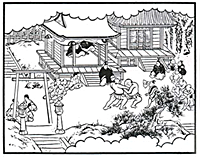
Age of Bushi(Warrior) On April 3 of 1st Bunji(A.D.1189),Yoritomo Minamoto,
the first Kamakura Shogun( a general of Warriors'government)had inspected
a sumo performance at Kamakura Hachiman Shrine. *Azuma Kagami* This is
the first Shogun Joran Sumo.(Sumo performance in presence of Shogun). On
October 15 of 1st Shoka (A.D.1257),Shogun Joran Sumo was done by Tokiyori
Hojo ,*Azuma Kagami* During Muromachi Era (A.D.1392 to A.D.1573),Ashikaga
Shoguns had often visited sumo performance.
and during later of this age,some sumo wrestlers became professional. On
March 3 of 1st Genki(A.D.1570), Shogun Joran Sumo was done by Nobunaga
Oda at Johrakuji Temple *Nobunagako Koki=Nabunaga Biography* On February
29 of 6th Tensho(A.D.1578), the same was done at Azuchi Castle. Even after
the succumb of Nobunaga, it was succeeded by Hideyoshi Toyotomi and Hidetsugu,
the son of Hideyoshi.
In 5th Bunroku(A.D.1596), 10 pro-sumo wrestlers resided in Kansai made
the first sumo tour in Chikugo, Kyushu. Edo era had started, and Kanjin
Sumo became popular in Kyoto, Edo (now Tokyo) and Osaka. Kanjin Sumo was
originally intended to contribute some profit to shrines or temples when
they are newly built or repaired. Local pro- sumo wrestler groups used
to join these activities. Gradually, even profit only professional sumo
was also called “Kanjin Sumo” . This is because a special permission was necessitated from Bakufu (Edo
Shognate Government)even for without- contribution sumo as well as Kanjin
Sumo .
. This is because a special permission was necessitated from Bakufu (Edo
Shognate Government)even for without- contribution sumo as well as Kanjin
Sumo .
When sumo is held, big sumo wrestlers loiter around and streets becomes
crowded and Taiko(sumo drum) from a scaffold sounds loudly from early morning and so on. So, impresario
of sumo performance had to obtain a pardon permission from Bakufu to cause
aforementioned inconvenience and noise among neighbors. When they are permitted,
a scaffold is set up for taiko yagura and a notice board called”Gomen-Fuda”
from a scaffold sounds loudly from early morning and so on. So, impresario
of sumo performance had to obtain a pardon permission from Bakufu to cause
aforementioned inconvenience and noise among neighbors. When they are permitted,
a scaffold is set up for taiko yagura and a notice board called”Gomen-Fuda”
(a pardon bulletin) saying that they obtained a permission
from authority concerned is hoisted with some ceremony. This practice is
succeeded by contemporary ohsumo as well. Immediately after an official
permission is obtained, they make some ceremony called “Gomen-Iwai” inviting
authorities concern such as municipal office, fire department, police,
health office and mass communication and they inform them of schedule etc
of basho(where sumo tournament is held). You can not start preparatory
works such as setup of taiko yagura(drum scaffolding)
saying that they obtained a permission
from authority concerned is hoisted with some ceremony. This practice is
succeeded by contemporary ohsumo as well. Immediately after an official
permission is obtained, they make some ceremony called “Gomen-Iwai” inviting
authorities concern such as municipal office, fire department, police,
health office and mass communication and they inform them of schedule etc
of basho(where sumo tournament is held). You can not start preparatory
works such as setup of taiko yagura(drum scaffolding) ,spectator seat, dohyo construction, advance ticketing and etc until you
finish Gomen Iwai. Thus, sumo is unique sports having a long tradition
and practice. In June of 2nd Shoho(A.D.1645),sumo in presence of imperial
highness was held at Tadamori, Kyoto.*Kokon Sumo Taizen=All Sumo History
Old & Now*
,spectator seat, dohyo construction, advance ticketing and etc until you
finish Gomen Iwai. Thus, sumo is unique sports having a long tradition
and practice. In June of 2nd Shoho(A.D.1645),sumo in presence of imperial
highness was held at Tadamori, Kyoto.*Kokon Sumo Taizen=All Sumo History
Old & Now*
In 1st Jyoukyo(A.D.1684), sumo in presence of Edo Shogunate was held at
Tomioka Hachiman Shrine, Tokyo. Thus, this shrine was called as origin
of Edo Kanjin Sumo. In 33rd Meiji(A.D.1901), Kyugoro Jinmaku, the 12th
Yokozuna, initiated to build epitaph  praising past Yokozunas together with
praising past Yokozunas together with
Hirofumi Itoh, Aritimo Yamagata, Shigenobu Ohkuma,(They are all outstanding
figures during Meiji Revolution).
In April of 15th Genroku(A.D.1702), Kanjin Sumo held at Horie,Osaka which
does not make any contribution to shrines or temples was first permitted
by Bakufu . This Kanjin Sumo was further developed to current ozumo.
During Kyoho Era(A.D.1716 to A.D.1735), sumo wrestlers ranking chart called
“banzuke” had appeared in both Osaka and Kyoto. In 7th Horeki(A.D.1757),
a vertically written banzuke was first issued in Tokyo. This indicated
Edo became independent from Osaka and Kyoto, banzuke of which were horizontally
written. In October of 11th Horeki(A.D.1761), the writing of Kanjin Sumo
held at Kuramae Hachiman Shrine had been changed to Kanjin Ohsumo. In November
of 1st Kansei (A.D.1789),Yoshida-Tsukasa family gave a license for Yokozuna
Dohyo-iri performance to Kisaburo Onogawa and Kajinosuke Tanikaze. This
is said as a substantial foundation of current Yokozuna system.
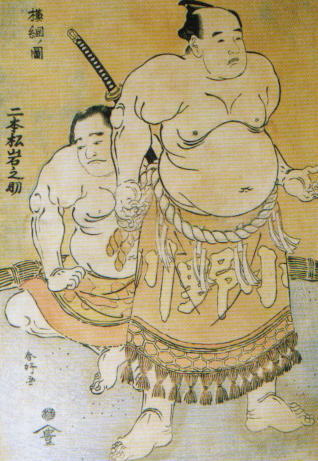
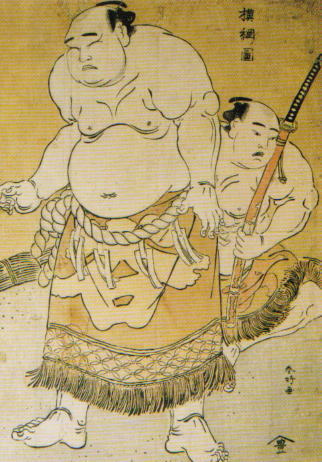
Kisaburo Onogawa Kajinosuke Tanikaze
In June of 3rd Kansei(A.D.1791),Shogun Joran Sumo by Ienari Tokugawa, 11th
Shogun of Edo Bakufu, was held at Edo Castle. Two strongmen of Kajinosuke
Tanikaze and Kisaburo Onogawa fought and Tanikaze, the winner, was given
a bow from the Shogun. Then, he danced raising arm up with a bow in hand
and brandished it to the four corners of dohyo. This is the origin of current
Yumi Torishiki.(Bow Receiving Ceremony). In 2nd Bunka(A.D.1805),the scuffle
caused by Me-gumi(a fraction of fire-fighters in Edo) had the spring tournament
of sumo cancelled. In October of 4th Tenpo(A.D.1833), Ekou-in , Honsjo,
Edo was fixed as an official place for sumo.

In April of 2nd Kaei (A.D.1849), Shogun Joran Sumo by Ieyoshi Tokugawa
was held at Edo Castle.
On June 3 of 6th Kaei (A.D.1853),Perry led a fleet of battleships to Uraga.
This point is a time of change in Japanese history. An Ukiyoe depicts a
sumo wrestler throwing a crew of the fleet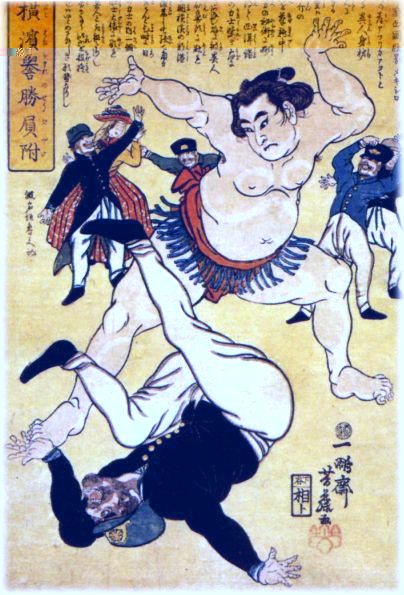 .
.
End of Edo era. Thus, feudal lords had bankrupted. Sumo wrestlers who feudal
lords employed became difficult to exist.
After the Meiji Restoration On April 17 of 4th Keio (1st Meiji,A.D.1868),The
Emperor Meiji had been presence at Kyoto sumo held at Zama Shrine,Osaka.
In March of 2nd Meiji(A.D.1869),Osaka sumo abolished their banzuke of horizontally
written of two(East/West) columns and unified to Edo style of vertical written
of one. In June of same year, Daimyo’s domains had been abolished,. Consequently,
their sumo wrestlers were unemployed. In March of 4th Meiji(A.D.1971),
a joint sumo of triple cities(Kyoto, Osaka and Tokyo)had first been held
in Kyoto. In August of same year, Meiji Restoration Government proclaimed
Bobbed Hair Order, but mage(sumo wrestler hair style) became exceptional
from this order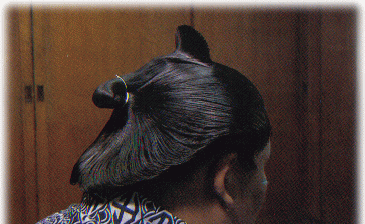 .
.
In January of 21st Meiji(A.D.1889), the letter of Juryo on banzuke sheet
was written a little bolder than before. In January of 22nd Meiji(A.D.1890),
Tokyo sumo had changed the nomination of Sumo Kaisho which had been used
from Edo era to Tokyo Ohkakuteii Kyokai(ozumo kyoukai) . and limited the
number of Toshiyori (retired sumo wrestlers who can stay at the association
after retirement as they own certain amount of the share)to 88. In February
of 42nd Meiji(A.D.1910), Tokyo ozumo Association added a stipulation clearly
stating that nomination of Yokozuna should be limited to champion wrestlers
only, not for the highest ranked wrestlers .
In June of same year, Kokugikan( national sumo game pavilion ) was built , so that it could be possible to hold 10 days successive performance without
any cessation regardless of weather. In January of 43rd Meiji(A.D.1911),
both Tokyo and Osaka ozumo Association had broken up their relationships
because of Yokzuna problem of Ohkido of Osaka. In November of 1st Taisho(A.D.1912),
both associations had reconciled. In September of 12th Taisho(A.D.1923),
Ryogoku Kokugikan had wholly been burned down by Kanto Mega Earthquake
, so that it could be possible to hold 10 days successive performance without
any cessation regardless of weather. In January of 43rd Meiji(A.D.1911),
both Tokyo and Osaka ozumo Association had broken up their relationships
because of Yokzuna problem of Ohkido of Osaka. In November of 1st Taisho(A.D.1912),
both associations had reconciled. In September of 12th Taisho(A.D.1923),
Ryogoku Kokugikan had wholly been burned down by Kanto Mega Earthquake
. In April of 14th Taisho(A.D.1925), sumo performance had been held to
cerebrate the birthday of The Emperor Showa at east court of Akasaka Imperial
Palace, Tokyo. With allowance from The Emperor Taisho, Emperor’s Cup to
be donated
In July of same year, both Tokyo and Osaka Ohsumo Associations, competing
with each other so far, had dissolved themselves and made a sign to unify
both associations into one. Tokyo had proposed Osaka that both ohsumo could
compete with each other for the Emperor’s Cup which had before been given
for Tokyo only. Thus, their face being saved, Osaka had accepted Tokyo’s
proposal and agreed to be unified. On December 28, Ministry of Education/Culture
had approved Dai-Nihon Sumo Kyoukai (Great Japan Sumo Wrestling Association),
as a public corporate. In 15th Taisho(A.D. 1926), Tsunenohna, 31st Yokozuna,
won the January basho and got the first Emperor’s Cup. In January of 2nd
Showa(A.D.1927), both Tokyo and Osaka Sumo Associations had officially
unified and named the unified Association as Great Japan Sumo Wrestling
Association. In January of 3rd Showa(A.D.1928), shikiri is regulated to
be lined in the span of 60 cm in between both lines of white at the center
of dohyo. Time limit for shikiri was also set up as being 10 minutes for
makuuchi, 7 minutes for juryo and 5 minutes for makushita. In May of 5th
Showa(A.D.1931), diameter of dohyo is also regulated as 15 shaku (4.95
m), and dually encircled straw bags into one. and the roof of dohyo to
be constructed in Shinmei style. In January of 7th Showa (A.D. 1937), those
sumo wrestlers of Dewanoumi faction ranked in west of banzuke besieged
Shunju-en, Ohoi,Tokyo, appealing to renewal of sumo-do(How should sumo
be). Some wrestlers ranked in east also joined this appeal, retiring from
the association. This caused cancellation of the January basho. This was
called as Shunju-en Incident. In 12th Showa(A.D.1937), Dai-Kokugikan (national
sumo pavilion) was completed at Sekime, Joto-ward, Osaka and pre -Osaka
basho was held on both days of June 12 & 13. In May of 14th Showa (A.D.1939),
sumo basho of 15 days started.
After Outbreak of Pacific War between Japan and U.S.A. In December of 16th
Showa (A.D.1941), Japan made a sudden attack in Pearl Harbor. The war between
Japan and U.S.A. had begun. Nevertheless, ohsumo had been continued as
follows; Showa(A.D.) Basho Champion Ranking Heya Outcome 16(1941) spring
Futabayama Yokozuna Tatsunami 14-1 summer Haguroyama Ozeki Tatsunami 14-1
17(1942) spring Futabayama Yokozuna Futabayama 14-1 summer Futabayama Yokozuna
Futabayama 13-2 18(1943) spring Futabayama Yokozuna Futabayama 15-0 summer
Futabayama Yokozuna Futabayama 15-0 19(1944) spring Saganohana Komusubi
Nishonoseki 13-2 summer Haguroyama Yokozuna Tatsunami 10-0 autumn Maedayama
Ozeki Takasago 9-1 20(1945) summer Bishuyama 1st Maegashira Isegahama 7-0
autumn Haguroyama Yokozuna Tatsunami 10-0 In 19th Showa(A.D.1944),
Ryogoku Kokugikan had been taken over by military. And some sumo wrestlers
had been called for a military training.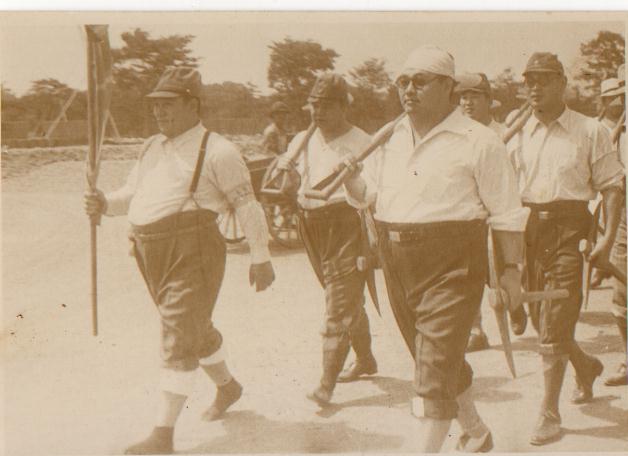
In May of same year, 10 days sumo when not rainy, was held at Korakuen
Stadium. In November, same was done at same place. In March of 20th Showa(A.D.1945),
by US air-strike, Ryogoku Kokugikan was damaged. In June of same year,
7 days sumo was held at damaged Kokugikan without any announcement. In
August of same year, the war had ended . In November of 20th Showa(A.D.1945),
first postwar hon-basho(regular tournament of ohsumo) of 10 days was held
at the damaged Ryogoku Kokugikan. In December of same year, US occupation
HQ had taken over Kokugikan. In 21st Showa(A.D.1946), hon-basho(summer)
had been cancelled since repairmen of the damaged Kokugikan had largely
been delayed. In June o 22nd Showa(A.D. 1947), natsu(summer)-basho of 10
days when not rainy was held at Meiji-Jingu-Gaien. In November of same
year, aki(autumn)-basho of 10 days when not rainy was held at the same
place. 3 awards of most valuable prize, fighting spirit prize and technically
excellent prize were established from this basho. In May of 23rd Showa(A.D.1948),
natsu-basho of 11 days when not rainy was held at Meiji-Jingu-Gaien. In
October of same year, hon-basho of 11 days was held at Osaka temporary
Kokugikan. In January of 24th Showa(A.D.1949), hon-basho of 13 days was
held at Hamacho temporary Kokugikan. In May of the same year, natsu-basho
of 15 days was held at Hamacho temporary Kokugikan. On October 23 of the
same year, Ozeki Chiyonoyama (Dewanoumi ) became champion at record of
13-2. In January of 25th Showa(1950), 15 days ohsumo was held at temporary
Kokugikan set up at Kuramae, Tokyo. Kuramae where matches were always heated
and people were so excited had repeatedly been repaired but no roof on
it. In January of 60th Showa(A.D.1985),new Kokugikan had been completed
at Ryogoku, Tokyo but in order to keep the atmosphere, roof had not been
set up there. In July of 27th Showa(A.D.1952), rikishi-nobori(sumo wrestler
banner) had been hoisted since 43 years when done at Ekoin, Honjo, Tokyo
of 42nd Meiji(A.D. 1910). In September of the same year, pillars had been
withdrawn from the four corners of dohyo and instead, four colored tassels
were hung from suspended roof . These four colored tassels of blue, red,
white and black are such talisman as protecting each of four corner s of
dohyo, namely east, south, west and north in order. It also means four
seasons of spring, summer, autumn and winter. In January of 28thShowa(A.D.1953),
it was decided that hon-basho would regularly beheld at 4 throughout the
year as spring ?basho at Osaka while summer, autumn and winter at Tokyo.In
September of 29th Showa(1954), Kuramae Kokugikan was completely repaired,
and natsu-basho was held there.
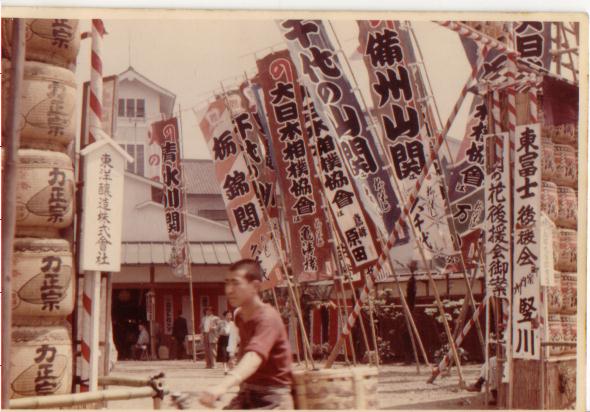
In May of 30th Showa(A.D.1955),
The Emperor Showa had inspected 10th day of natsu-basho held at Kuramae Kokugikan for the first time since end of the Pacific War. And he left tanka( Japanese brief poem) chanting his relief from miserable
war with settlement and recovery and appreciation of being peaceful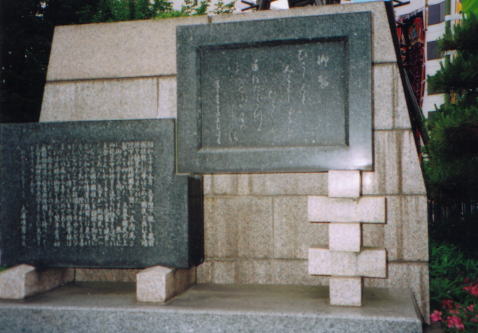
In January of 32nd Showa(A.D.1957), it was decided to add one more sumo tournament in November
at Kyushu to said four basho. Thus, hon ?basho became 5. In January of 33rd Showa(A.D.1958),
it was also decided to add one more in July at Nagoya, Thus hon-basho became 6 in total. In January
of the same year, Dai Nihon Sumo Kyokai had been altered to Nihon Sumo Kyokai(Japan Sumo
Wrestling Association). The 2nd chapter of the corporate stipulation says that they intend a healthy
growth of sumo-do and contribute to the public for their physical or spiritual betterment.
In March of the same year, Wakanohana, the 45th Yokozuna ,inaugurated. Since then, a boom
of Tochi (Tochinishiki, powerful Yokozuna opponent of Wakanohana)vs Waka Age had come.
In due course of TV prevailing throughout this country of this age, another good matches such
as Taiho vsKashiwado Age, Kitanoumi vs Takanohana Age, Chiyonofuji hegemony became booming
successively.
In January of 43rd Showa(A.D.1968), Prime Minister Award was newly established.
In May of 45th Showa(A.D.1970), span of both shikiri lines was extended to 70 cm from 60 cm.
On October 4 of 59th Showa(A.D. 1984), Kuramae Kokugikan had been closed.
In January of 60th Showa(A.D.1985), Ryogoku Kokugikan had newly been opened.
In January of 7th Heisei(A.D.1995), Takanohana, the 65th Yokozuna, inaugurated.
In July of 10th Heisei(A.D.1998), Wakanohana, the 66th Yokozuna, inaugurayed.
Waka-Taka age had started. In January of 13th Heisei(A.D.2001), number
of trick was officially limited to 82. Physical check for recruiting sumo
wrestler newly was revised as; 173 m minimum for height and 75 kg minimum
for weight for first pass and for those who could not reach minimum required
in the first pass can get another test of their physical ability if they
are higher than 167 cm and heavier than 67 kg. There was also a revision
in makushita ranking system; according to outcome of amateur sumo, the
can be classified into makushita 10th to 15th grade. In March of 15th Heisei(A.D.2003),
Asashoryu, the 68th Yokozuna, inaugurated. Local sumo tour was changed
from a volunteering of Japan Sumo Wrestling Association to sold-out to
each local impresario. In January of 16th Heisei(A.D.2004), official injury
rule was abolished. Activity of foreign sumo wrestlers became outstanding
in upper ranks. In December of 17th Heisei(A.D.2005), Japan Sumo Wrestling
Association cerebrated the 80th birth since its corporate In 19th Heisei(A.D.2007),
May tournament counted a record high18 foreign sumo wrestlers . In July
of the same year, Nagoya-basho cerebrated 50th birth since its debut. In
September of 20th Heisei(A.D.2008), the Association had first called in
council member from outer circle. In January of 22nd Heisei(A.D.2010),
Asashoryu, Yokozuna fromMongol ,the3rd ranked championship winner of 25
times in sumo history, had to quit himself from ohsumo because of lack
of Yokozuna decency qualification. On October 10th of the same year, Sumainosechie
as a national ceremony of July 7 in presence of then Emperor had reappeared
at Heijokyo site of Nara city when they cerebrated 1300th years since transfer
of their capitol to Heijokyo in Nara. There,10 amateur sumo wrestlers performed
it waiting for the emperor’s judgment for ambiguous match as thought so
in Sumainosechie. In March of 23rd Heisei(A.D.2011), the March tournament
had been cancelled. Cancellation of hon basho is only twice in ohsumo history
. Another one is natsu-basho of 21st Showa for delay of repairmen of bombarded
Kokugikan . In April of the same year, hon-basho of May had been held free
without admission fee as titled as a checking basho of sumo wrestlers technicality.
In July of the same year, ohsumo had been normalized, holding July tournament.
In January of 24th Heisei(A.D.2012), Kitanoumi was elected as 12th director
general of the association.
 Back to the Page Sumo 相撲 四季通販 へ戻る
Back to the Page Sumo 相撲 四季通販 へ戻る
site map サイトマップ

 , Shirumu in Korea and wrestling in Turkey and other parts of Eurasia continent. A mural painting of caves alongside the Nile River of 2,500 years ago depicts men’s bout of wresting. So, it may be said that bout is an intuitive expression of healthy human beings to show his strength It also symbolizes each local character. And some had developed to current wrestling and other to sumo. Today, we have seen an influx of hopeful youngsters from overseas countries into ozumo to compete with native Japanese sumo wrestlers.
, Shirumu in Korea and wrestling in Turkey and other parts of Eurasia continent. A mural painting of caves alongside the Nile River of 2,500 years ago depicts men’s bout of wresting. So, it may be said that bout is an intuitive expression of healthy human beings to show his strength It also symbolizes each local character. And some had developed to current wrestling and other to sumo. Today, we have seen an influx of hopeful youngsters from overseas countries into ozumo to compete with native Japanese sumo wrestlers. 
 and “ Karasu-Sumo”(Raven Sumo). The former is to pray for infants steady
growth . Many shrines and temples throughout this country have long been
succeeding this tradion, while the latter storied that Kamotake-Tsunuminomikoto,
the grand father of the founder of Kamigamo Shrine in Kyoto led The Emperor
Jinmu to conquer his enemies resided in eastern Japan in his disguise of
a huge and wondrous raven and contributed a lot to its success. Sumo symbolizes
this religious event, driving evil-spirits away from a sacred place. In
fact, a sumo wrestler in disguise of Tone (warrior) holding a bow and arrow
imitates raven cawing and afterward, boys used to play sumo. Whenever we
have a festive, we are to hold sumo championship at the festive site. Originally,
shape and largeness of dohyo had not been fixed. some were square and others
round but in dual rounds. The largeness of dohyo was rather smaller than
current one. Currently, it is regulated that it should be round in encircled
with 20 small straw bags and 4.55 m in diameter while two shikiri(getting
off the mark) of white color must be lined at 70 cm in between at the center
of dohyo.
and “ Karasu-Sumo”(Raven Sumo). The former is to pray for infants steady
growth . Many shrines and temples throughout this country have long been
succeeding this tradion, while the latter storied that Kamotake-Tsunuminomikoto,
the grand father of the founder of Kamigamo Shrine in Kyoto led The Emperor
Jinmu to conquer his enemies resided in eastern Japan in his disguise of
a huge and wondrous raven and contributed a lot to its success. Sumo symbolizes
this religious event, driving evil-spirits away from a sacred place. In
fact, a sumo wrestler in disguise of Tone (warrior) holding a bow and arrow
imitates raven cawing and afterward, boys used to play sumo. Whenever we
have a festive, we are to hold sumo championship at the festive site. Originally,
shape and largeness of dohyo had not been fixed. some were square and others
round but in dual rounds. The largeness of dohyo was rather smaller than
current one. Currently, it is regulated that it should be round in encircled
with 20 small straw bags and 4.55 m in diameter while two shikiri(getting
off the mark) of white color must be lined at 70 cm in between at the center
of dohyo.
 and Tagimano-Kuehaya
and Tagimano-Kuehaya . In this match, Sukune kicked Kuehaya down to the earth. Kicking down
is not allowed in contemporary sumo. Although this was totally different
from existing sumo, Sukune, is anyhow, deemed as father of sumo.
. In this match, Sukune kicked Kuehaya down to the earth. Kicking down
is not allowed in contemporary sumo. Although this was totally different
from existing sumo, Sukune, is anyhow, deemed as father of sumo. . Furthermore, there are epitaphs and/or five roofed stone towers(built
in early years of Kamakura era) praising Sukune’s achievement at 12 gods
shrines in Sakurai city, Nara and Izumo, Shimane.
. Furthermore, there are epitaphs and/or five roofed stone towers(built
in early years of Kamakura era) praising Sukune’s achievement at 12 gods
shrines in Sakurai city, Nara and Izumo, Shimane. 
 . This is because a special permission was necessitated from Bakufu (Edo
Shognate Government)even for without- contribution sumo as well as Kanjin
Sumo .
. This is because a special permission was necessitated from Bakufu (Edo
Shognate Government)even for without- contribution sumo as well as Kanjin
Sumo . from a scaffold sounds loudly from early morning and so on. So, impresario
of sumo performance had to obtain a pardon permission from Bakufu to cause
aforementioned inconvenience and noise among neighbors. When they are permitted,
a scaffold is set up for taiko yagura and a notice board called”Gomen-Fuda”
from a scaffold sounds loudly from early morning and so on. So, impresario
of sumo performance had to obtain a pardon permission from Bakufu to cause
aforementioned inconvenience and noise among neighbors. When they are permitted,
a scaffold is set up for taiko yagura and a notice board called”Gomen-Fuda” saying that they obtained a permission
from authority concerned is hoisted with some ceremony. This practice is
succeeded by contemporary ohsumo as well. Immediately after an official
permission is obtained, they make some ceremony called “Gomen-Iwai” inviting
authorities concern such as municipal office, fire department, police,
health office and mass communication and they inform them of schedule etc
of basho(where sumo tournament is held). You can not start preparatory
works such as setup of taiko yagura(drum scaffolding)
saying that they obtained a permission
from authority concerned is hoisted with some ceremony. This practice is
succeeded by contemporary ohsumo as well. Immediately after an official
permission is obtained, they make some ceremony called “Gomen-Iwai” inviting
authorities concern such as municipal office, fire department, police,
health office and mass communication and they inform them of schedule etc
of basho(where sumo tournament is held). You can not start preparatory
works such as setup of taiko yagura(drum scaffolding) ,spectator seat, dohyo construction, advance ticketing and etc until you
finish Gomen Iwai. Thus, sumo is unique sports having a long tradition
and practice. In June of 2nd Shoho(A.D.1645),sumo in presence of imperial
highness was held at Tadamori, Kyoto.*Kokon Sumo Taizen=All Sumo History
Old & Now*
,spectator seat, dohyo construction, advance ticketing and etc until you
finish Gomen Iwai. Thus, sumo is unique sports having a long tradition
and practice. In June of 2nd Shoho(A.D.1645),sumo in presence of imperial
highness was held at Tadamori, Kyoto.*Kokon Sumo Taizen=All Sumo History
Old & Now*  praising past Yokozunas together with
praising past Yokozunas together with 

 .
.  .
. , so that it could be possible to hold 10 days successive performance without
any cessation regardless of weather. In January of 43rd Meiji(A.D.1911),
both Tokyo and Osaka ozumo Association had broken up their relationships
because of Yokzuna problem of Ohkido of Osaka. In November of 1st Taisho(A.D.1912),
both associations had reconciled. In September of 12th Taisho(A.D.1923),
Ryogoku Kokugikan had wholly been burned down by Kanto Mega Earthquake
, so that it could be possible to hold 10 days successive performance without
any cessation regardless of weather. In January of 43rd Meiji(A.D.1911),
both Tokyo and Osaka ozumo Association had broken up their relationships
because of Yokzuna problem of Ohkido of Osaka. In November of 1st Taisho(A.D.1912),
both associations had reconciled. In September of 12th Taisho(A.D.1923),
Ryogoku Kokugikan had wholly been burned down by Kanto Mega Earthquake




 Back to the Page Sumo 相撲 四季通販 へ戻る
Back to the Page Sumo 相撲 四季通販 へ戻る